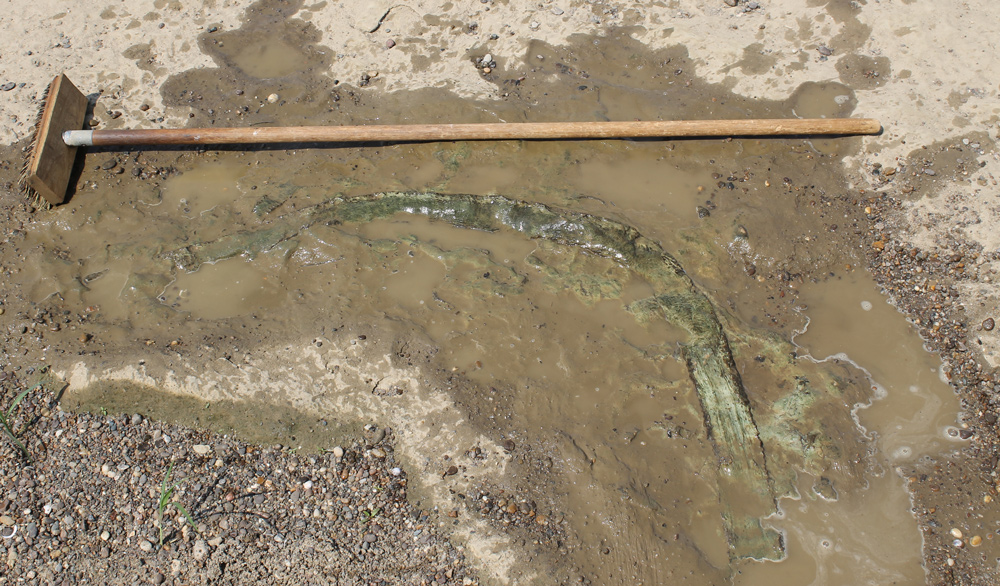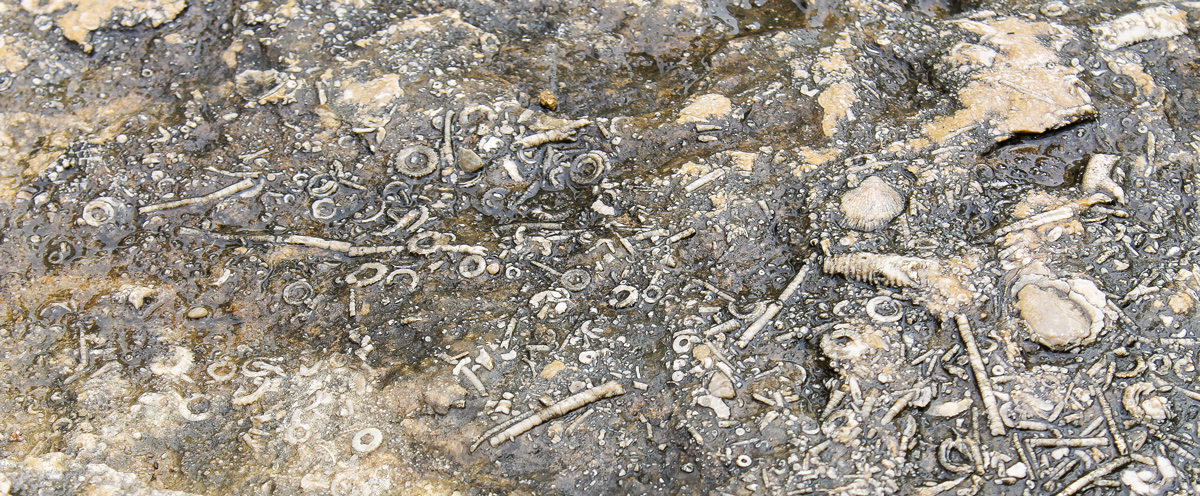In Louisville, George Gibson, John Shields, and George Shannonn officially enlist as privates in the “corps of volunteers for North West Discovery”. The Clarksville fossil beds on the other side of the Ohio River are described by contemporary travelers Thomas Rodney and Josiah Epsy.
Large Rugose Coral
Siphonophrentis gigantea
Courtesy Alan Goldstein of the Falls of the Ohio State Park.
The above rugose coral is one of the longest known specimens—four feet!
Rodney’s ‘Rock Worms’
Whatever Lewis’s impressions of the fossils were, we have no existing record of them. Rodney, less trained in paleontology than Lewis, recorded his interpretation:
[O]bserved the rock worm, which are kind of stoney and shelly substance in the form of large worms that grow in the rocks that forms the falls, of various [size], from 4 to ten inches long and some two inches diameter, the rock being sothe [softer] than the worms washes away and leaves part of them exposed . . . .
—Thomas Rodney (16 October 1803)[1]Dwight L. Smith and Ray Swick, ed., A Journey Through the West: Thomas Rodney’s 1803 Journal from Delaware to the Mississippi Territory (Athens: Ohio University Press, 1997), 121–22.
The day after Rodney recorded this observation, Lewis and Clark visited him on his bateaux (see October 17, 1803). Rodney’s specimens likely came up in the evening’s conversation.
Petrifactions
In 1805, while Lewis and Clark were crossing the continent, Josiah Espy recorded his observations of the fossils:
The beach and whole bed of the river for two or three miles here is one continued body of limestone and petrifactions. The infinite variety of the latter are equally elegant and astonishing. All kinds of roots, flowers, shells, bones, buffalo horns, buffalo dung, yellow-jacket’s nests, etc., are promiscuously seen in every direction on the extensive beach at low water, in perfect form.
—Josiah Epsy (1805)[2]Josiah Epsy, Memorandums of a Tour Made by Josiah Epsy in the States of Ohio and Kentucky and Indiana Territory in 1805 (Cincinnati: Robert Clarke & Co., 1870), 14
The fossils are actually corals, gastropods (snails), and other shelled animals, called brachiopods and bryozoan.[3]Falls of the Ohio National Wildlife Conservation Area (https://en.wikipedia.org/wiki/Falls_of_the_Ohio_National_Wildlife_Conservation_Area) accessed on 13 January 2019.
Ohio River Recruits
In a summary of extra pay awarded the men, Clark recorded the enlistments of privates Gibson, Shields, and Shannon as starting on this day:
We the Subscribers do acknowledge to have received of [blank] the several Sums set opposite to our names, the Same being due us from the War department pursuant to an Act of Congress bearing date March 3rd 1807, entitled ‘an Act makeing compensation to Messrs. Lewis & Clark and their companions.
. . . .
Name Period of Service Monthly Rate Amount George Gibson 19 Oct. 1803 to 10 Oct. 1806 5 [$]178.50 John Shields 19 Oct. 1803 to 10 Oct. 1806 5 178.50 George Shannon 19 Oct. 1803 to 10 Oct. 1806 5 178.50[4]Donald Jackson citing Yale University Library, New Haven, Connecticut in Letters of the Lewis and Clark Expedition with Related Documents: 1783-1854, 2nd ed. (Urbana: University of Illinois Press, … Continue reading
Experience the Lewis and Clark Trail
The Lewis and Clark Trail Experience—our sister site at lewisandclark.travel—connects the world to people and places on the Lewis and Clark Trail.
Plan a trip related to October 19, 1803:

Notes
| ↑1 | Dwight L. Smith and Ray Swick, ed., A Journey Through the West: Thomas Rodney’s 1803 Journal from Delaware to the Mississippi Territory (Athens: Ohio University Press, 1997), 121–22. |
|---|---|
| ↑2 | Josiah Epsy, Memorandums of a Tour Made by Josiah Epsy in the States of Ohio and Kentucky and Indiana Territory in 1805 (Cincinnati: Robert Clarke & Co., 1870), 14 |
| ↑3 | Falls of the Ohio National Wildlife Conservation Area (https://en.wikipedia.org/wiki/Falls_of_the_Ohio_National_Wildlife_Conservation_Area) accessed on 13 January 2019. |
| ↑4 | Donald Jackson citing Yale University Library, New Haven, Connecticut in Letters of the Lewis and Clark Expedition with Related Documents: 1783-1854, 2nd ed. (Urbana: University of Illinois Press, 1978), 2:378. |


